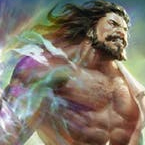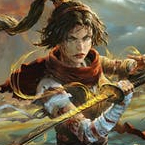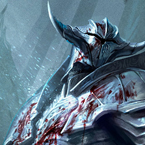They say no man is an island, and I'm inclined to agree. I have spent over twenty years playing card games, and while I've had great games with perfect strangers, the best memories aren't those competitive matches. It's the time I've shared with friends, working out decks with my testing team. It's true that, when you sit down to play Flesh and Blood, the only person at the tournament table who is actively on your team is yourself- but I would likewise contend that finding victory at that tournament table is a concerted effort. In this piece, I want to explore this premise with you: Flesh and Blood is a team sport.
What Makes a Good Team?
A competitive team needs to be diverse- the players and contributors on your team should have differing ideas and different skill sets. Having a well-balanced team of players means that everyone on the team brings something different to the testing table. You want to have players who prefer to play in different ways: aggro players, control players, combo players, and all those alternative inclinations that aren't so easily defined. You want players who are interested in different heroes, too; it's of little to no use if every person on your team plays the same heroes in the same ways.
However, your team shouldn't be too large to manage, or you risk developing factions within the team. I have found that a good team size is between three and six players. Two players is just barely too few most times; if one of you is unable to test or talk, then neither of you are progressing within the team structure. Seven or more players, and now you're dealing with a crowd, and you're ever more susceptible to groupthink- where everyone in the group agrees on an idea and nobody contests its truth. The individuals that make up your team need to have voices that are strong enough, and respected enough, to be neither ignored nor drowned out.
I have found that a good team size is between three and six players.
Each player should be bringing something different to the table. There will be overlap in skills, certainly, but ideally a good team will have diversity of thought and approach. The more overlap you have in an area, the more that the group will be pulled in that direction by the same mechanism as groupthink. If everyone's uniqueness is honored and respected, then different ideas can flourish. This is the very definition of a growth mindset, and it is incredibly valuable in a card game team. A competitive decklist is never done evolving, and by letting new and different ideas approach the question of “What could make this deck better?”, you can expedite its refinement. This is also true for the pilot! We all have room to grow, and regularly facing a wide variety of players and play styles cultivates that growth.
Focus is a huge part of team play. For example, during Monarch's spoiler season, we started assigning heroes to teammates. I took up Prism, my wife took on Chane, and two other team members took up Boltyn and Levia. We spent the ensuing weeks studying their cards, building decks, and testing against each other's theoretical builds and old standards. We followed the new lists popping up on FABDB, updating our lists and trying out new ideas as they broke across the world.
A competitive decklist is never done evolving.
Had any one of us been tasked with figuring out all of the heroes, they would have surely failed! Their group of one would have only one perspective, one lens through which to view the cards and the competing lists, one voice of consent or dissent. Instead, we all bore the burden that a new sets puts upon us, and we all progressed because of it.
Time and proximity are absolutely massive factors to what makes up a team. You don't necessarily need a strict schedule of meetups, but a team that doesn't practice together is hardly a team at all. Your meetups don't have to be in the game shop; you can discuss ideas over the internet, test decks against each other on your kitchen table, and basically utilize any available avenue. But you have to be dedicated to the effort and frequently engaged in each other's progress.
Team Tryouts
Finding a team is one of the most important parts to being in a team: you can't be in a team if there isn't a team to be on. Sometimes this means starting your own team- that's how my own team came together in Colorado Springs. The core of Team All Carded Out had known each other for some five or six years before we coalesced. We have since added two more members who we had only met this year. Your team doesn't need to share a long history, you just need to be committed to pursuing improvement.
Each one of your teammates needs to be ready to receive constructive criticism from every other team member- and give constructive criticisms in kind. This is a large part of the growth mindset we talked about earlier. If you can't hear criticisms about your plays and ideas, then you will have a hard time improving those plays and ideas. If those things can't improve, then it will be monumentally difficult to improve as a player.
Lucky for you, your local game store already has the seeds of a team. If you attend your LGS' open game nights, league nights, tournaments, etc, then you probably know of a few players that might just want to make up a competitive team. The first step is to just start talking about the game with the people you see regularly in the same FAB circles. Look for signs of interest in taking their game up another level or two. Once you have a handful of people who all want to get better, see if you can all play together. Try to meet up at the LGS a few times and jam games together. If you can all stand being around each-other, then you've got the loam you need to start growing your competitive team up.
The Pudding (Where the Proof Is)
I've been playing card games for more than twenty years, and I've been party to plenty of leagues and groups. But I've never formed a competitive team until this year. This is also the first year that any of us in the team have done as well as we did. In a field of 37 contenders, I won a Road to Nationals, while my teammate Ryan took 3rd. We both started playing FaB in April of this year, and that tournament was August 14th.
When playing other card games- before I was in a team, before Flesh and Blood- I took it upon myself to learn the new cards, the new decks, and the new meta.
I tried to build my own stuff, but eventually I gave up on that prospect: the task was too much, and other people are smarter than me at doing this sort of thing. (I would leave it up to the other taste makers, the Chapin's and Code Marvellous's of the world.)
With my team, the burden is not entirely on my shoulders. I was able to research and test Prism without dedicating more processing power to understanding other pockets and corners of the meta. My teammates were each pursuing other aspects of the meta. We were reporting to each other several times a week. And although I would never claim that we had figured out the whole meta, we definitely got a lot further than any of us ever had previously.
So What Do We Even Do? Get T-Shirts?
Of course, forming a team is just one of the first steps. Once you have a group of people who:
- are available
- want to play games together
- have ideas
- challenge each other and
- are ready to be challenged
then the real work begins.
Instead of just doing pick-up games, you and the team can make a schedule. You can figure out what the best times to meet up and jam are- no more waiting around on players to show up or for that one guy in the facebook group to post that they'll be up at the shop. My testing team often meets at the LGS so that we can still play with other people- it's not like you have to exclusively play with your teammates! Plus, playing with other people will help you bring ideas back to the team for evaluation and testing.
With that schedule, the team can undertake The Great Work of understanding the game, together. Here's some of how we do that at Team All Carded Out.
Test Sesh:
We get together two to four days of the week and jam games back to back to back. We try to fit 10+ games in these sessions. That might seem like a lot- and it is!- but at a major tournament, you will be tasked with playing 10+ games some days. You will want to be practiced for that. At Road to Nationals, I played 9 tournament games that day, and there is just no way in hell that I was going to win the final game if I was exhausted.
On top of that, test sesh's aren't just about repeat plays; they are mostly about testing new cards and tech. At our most recent test session, we pushed and evolved the Bravo list I've been working with.
The traditional loop for deck improvement looks like this:
- Play games
- Have ideas
- Go home, implement ideas
- Wait a week for the next tourney
- Test those ideas at the tourney
The TACO loop looks more like this:
- Play game
- Have ideas and talk about them
- Implement ideas within 5 minutes
- Test those ideas right away
- Have ideas and talk about them
- Implement ideas within 5 minutes...
And at the end of five or six hours, your decks will have evolved further than they could have in two to four weeks under the traditional model!
Here's a closer look, using the Bravo deck I took to RtN victory as an example.
In testing, I noticed a few things about my Bravo:
- He was under-performing vs the local flavor of Chane
- I was almost always siding out the 3 red Fate Foreseen
- Is yellow Disable really earning its place in the deck?
- I hardly ever play blue Pummel or Snag.
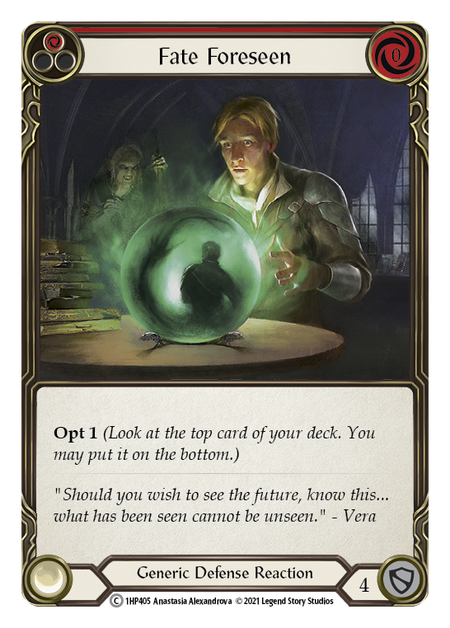

With these things in mind, I developed a plan of action with my testing partners.
- First, we tested Fate Foreseen- or more specifically, without them. I knew that I mostly only used Fate Foreseen against the Warrior matchups and Katsu, so I jammed a few games back to back and found that the deck was actually performing well without them. Sometimes I missed them against Axes Thea or Aggro Katsu, but I wasn't dropping those games, so they seemed like a safe cut.
- We did the same thing with Pummel, and found that it needed to stay. Being able to threaten a twice-pummeled Zealous Belting was too strong to cut.
- Next, yellow Disable went up on the chopping block. I've long held that this is our Command and Conquer ortholog, but I'm always willing to hear the protestations of my testing partners. When Keenan suggested that CnC was the better play, we tested it out. I found that, even though it was only shifting a yellow to a red, the resource availability in the deck went down. There were more than a few all-red hands, and that was enough for me to say that Disable stays.
- Then, in his testing, my test partner reported back that: “it was a weird play, but I popped Mage Master Boots, Show Time'd for a yellow Disable, discarded two yellows to destroy the Library, and watched the light leave the Prism player's eyes.” That totally sealed the deal for us: CnC is good, but it doesn't stop Library Prism the same way Disable does. Plus, Disable is an 8 attack, and can survive a yellow blinding beam.
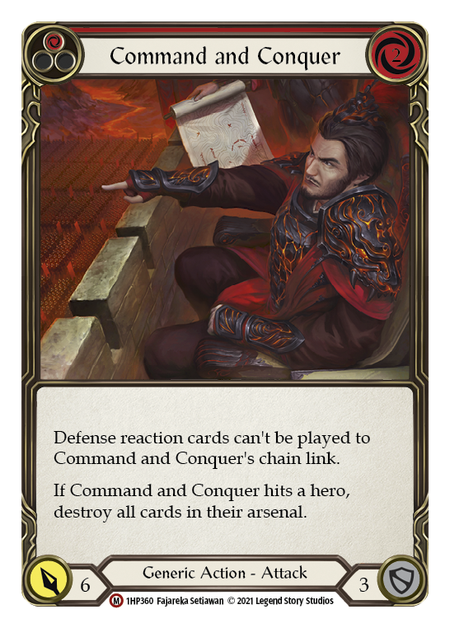
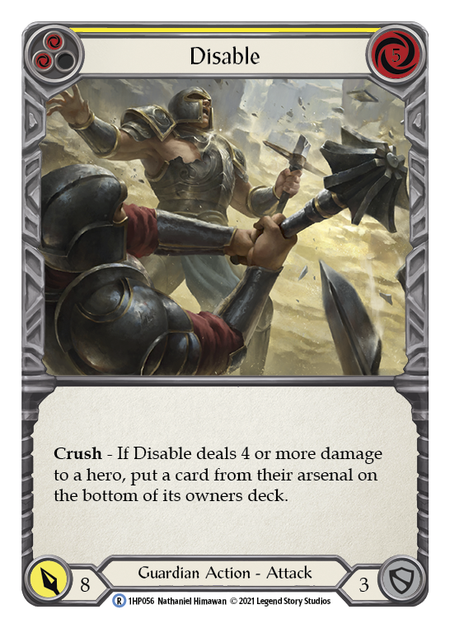
- Now that we had opened up a few sideboard slots, by leaving the Fate Foreseen out of the deck we turned our weary eyes to the local menace: Chane. What tools could we use to stop Chane? Well, red Crush the Weak was a good start, and even red Crush Confidence can be doozy. Plus, they boast the same double-Pummel threat that Zealous Belting does if you have gotten a Seismic Surge token from the previous turn. We tested those over and over, and they seemed to be the difference makers... but in those sessions, we also noticed that Chane was able to successfully play around Snag. We only had the one to begin with, but the Chane of the week didn't seem to be doing very much Rift Binding.

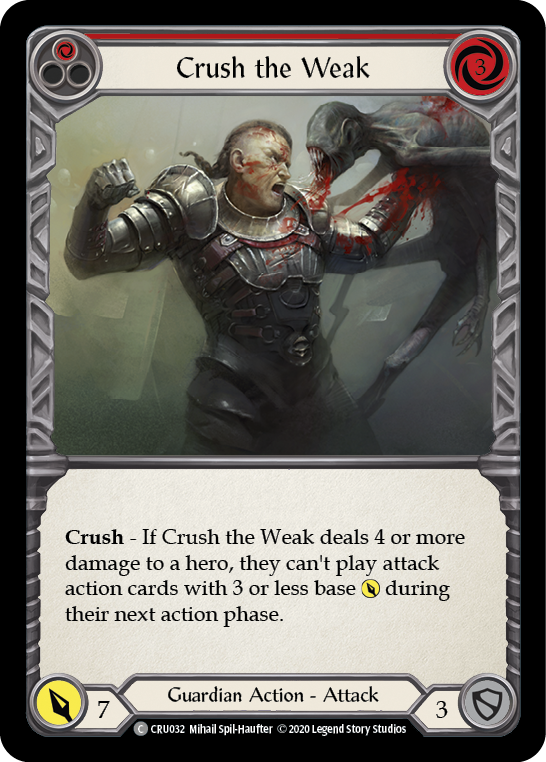
- This launched a subset of testing where we tried to play vs Katsu and Bravo and Chane without Snag, and found that it just was not performing enough to keep its spot. Snag doesn't cue Anothos or Blessing of Deliverence; Razor Reflex and Pummel are devastating, but only being able to occasionally stop one if we happened to draw Snag at the right moment just wasn't enough.
- With yet another sideboard slot opened up, bringing us back to 4 slots, our eyes wandered back to the chopping block of yore: could we fit Mangle back in? So we tried filling the slots with 3 red Crush the Weak and 1 Mangle, but CTW isn't always good. It's normally good vs the people that Mangle isn't (like Ninja), so what about 2 CTW, 2 Mangle? That also didn't seem to be working. What we landed on next turned out to be the right mix of spice: 1 red Crush Confidence, 1 Mangle, and 2 red Crush the Weak. Combined with Zealous Belting, Spinal Crush, and Crippling Crush, we now had a suite of red attacks to draw from whenever we sat down across from an opponent.

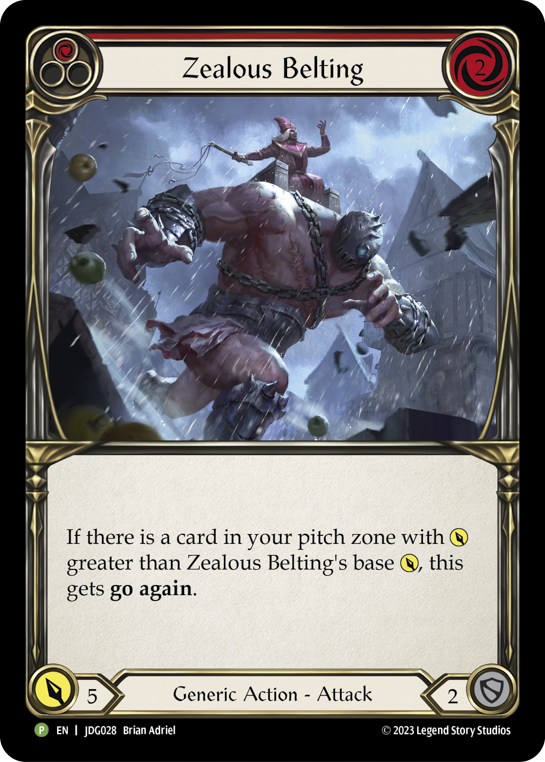
- But the testing wasn't over! Scuttlebutt around town was that an east wind was coming, and Kano was riding it to Road to Nationals. What to do!? Well, the deck already had room made for three Nullrune equipment (not the head, that's for the Skullcap)... could we fit a fourth?
And so the process continued. A competitive decklist is never done evolving: we can only get it as refined as possible before getting to the tournament tables.
Match Play:
Whenever we play a game, we actually play two games. In this game, and in so many others, there is a significant difference between going first and going second. As such, when we play, we play twice. There's no point in only practicing at the advantage or disadvantage: you really need experience doing both. At a big tournament, you won't have that luxury, so you will want to be well versed in what to do when going both first and second with your decks.
Testing Gauntlet:
When we test, we typically dedicate a session to a given hero or player. When that happens, everyone else pitches in by playing all the different decks against that player/hero. Since the goal is to evolve a given deck, all resources are dedicated to doing so: we're not playing our main heroes, and we're not focused on improving ourselves. At the most recent testing gauntlet sesh, Dash was put through the ringer over and over again. She faced all 12 heroes, including herself, including variations on certain heroes- it was practically 30 games across two days. Frankly, this sort of thing is just untenable for teams of one, and can only be achieved with partners... and decks.
Speaking of decks, let's talk about how many decks you'll need to have built. If each player likes one or two heroes, then you will very likely have a good number of decks on hand already- but what if you have overlap? And what if you can't afford to have 24 decks built, each with 3 Command and Conquers? Well, you're not alone! We don't have 72 Command and Conquers, let me tell you that! What we do have is a printer, a paper cutter, cheap sleeves, and a bunch of bulk. Using these tools alongside the excellent FABDB and FABTCG decklists, we do have a lot of competitive lists built, ranging from RTN winners and high-finishers from all over the world. Investing in a good printer is no small thing, and you can use your local Staples self-service kiosk in the meantime, but having access to the decks for testing is of such a high importance. Alternative proxying services include Table Top Simulator, OCTGN, Lackey, and the like.
Team All Carded Out plays Flesh and Blood in the flesh and blood, so we don't endorse any particular digital platforms. Use what you like!
And, uh, yeah... we're probably going to get TACO shirts.
Be A Team Player
If you're looking to advance in TCGs, you probably are going to want to join a competitive team- or make one. Get out there and find some like-minded players, and sharpen your blades. Another tournament is right around the corner (Vegas, anyone?), and I would love to meet you and your teammates at the top tables.



